Hygrothermal and Acoustical Performance of Starch-Beet Pulp Composites for Building Thermal Insulation
Abstract
:1. Introduction
2. Materials and Methods
2.1. Extruded Beet Pulp (BP)
2.2. Potato Starch
2.3. Composite Formulations
2.4. Density and Porosity
2.5. Sound Absorption Coefficient
2.6. Thermal Conductivity
2.7. Permeability
2.8. Sorption Isotherm
2.9. Moisture Buffer Value (MBV)
3. Results and Discussions
3.1. Porosity Analysis
3.2. Sound Absorption Coefficient
3.3. Thermal Conductivity, Diffusivity and Effusivity
3.4. Permeability
3.5. Sorption Isotherm
3.6. Moisture Buffer Value
4. Conclusions
Author Contributions
Funding
Conflicts of Interest
References
- Cerolini, S.; D’Orazio, M.; Di Perna, C.; Stazi, A. Moisture buffering capacity of highly absorbing materials. Energy Build. 2009, 41, 164–168. [Google Scholar] [CrossRef]
- Niang, I.; Maalouf, C.; Moussa, T.; Bliard, C.; Samin, E.; Thomachot-Schneider, C.; Lachi, M.; Pron, H.; Mai, T.H.; Gaye, S. Hygrothermal performance of various Typha-clay composite. J. Build. Phys. 2018, 1744–2591. [Google Scholar] [CrossRef]
- Capros, P.; De Vita, A.; Tasios, N.; Papadopoulos, D.; Siskos, P.; Apostolaki, E.; Zampara, M.; Paroussos, L.; Fragiadakis, K.; Kouvaritakis, N.; et al. EU Commision. Trends to 2050; European Union: Luxembourg, 2013; Available online: https://ec.europa.eu/transport/sites/transport/files/media/publications/doc/trends-to-2050-update 2013.pdf (accessed on 10 March 2018).
- Collet, F.; Chamoin, J.; Pretot, S.; Lanos, C. Comparison of the hygric behaviour of three hemp concretes. Energy Build. 2013, 62, 294–303. [Google Scholar] [CrossRef]
- Maalouf, C.; Ingrao, C.; Scrucca, F.; Moussa, T.; Bourdot, A.; Tricase, C.; Presciutti, A.; Asdrubali, F. An energy and carbon footprint assessment upon the usage of hemp-lime concrete and recycled-PET façades for of fi ce facilities in France and Italy. J. Clean. Prod. 2018, 170, 1640–1653. [Google Scholar] [CrossRef]
- Moussa, T.; Maalouf, C.; Ingrao, C.; Scrucca, F.; Asdrubali, F. Bio-based and recycled-waste materials in buildings: A study of energy performance of hemp-lime concrete and recycled-PET façades for office facilities in France and Italy. Sci. Technol. Built Environ. 2018, 492–501. [Google Scholar] [CrossRef]
- Pavelek, M.; Prajer, M.; Trgala, K. Static and dynamic thermal characterization of timber frame/wheat (Triticum Aestivum) chaff thermal insulation panel for sustainable building construction. Sustainability 2018, 10, 2363. [Google Scholar] [CrossRef]
- Bourdot, A.; Moussa, T.; Gacoin, A.; Maalouf, C.; Vazquez, P.; Thomachot-Schneider, C.; Bliard, C.; Merabtine, A.; Lachi, M.; Douzane, O.; et al. Characterization of a hemp-based agro-material: Influence of starch ratio and hemp shive size on physical, mechanical and hygrothermal properties. Energy Build. 2017, 153, 501–512. [Google Scholar] [CrossRef]
- Mazhoud, B.; Collet, F.; Pretot, S.; Lanos, C. Development and hygric and thermal characterization of hemp-clay composite. Eur. J. Environ. Civ. Eng. 2017, 8189, 1–11. [Google Scholar] [CrossRef]
- Moussa, T.; Maalouf, C.; Lachi, M.; Umurigirwa, S.; Mai, T.H.; Henry, J.F. Development and performance evaluation of a hemp-starch composite. J. Build. Phys. 2016, 40, 278–295. [Google Scholar] [CrossRef]
- Umurigirwa-Vasseur, B.S. Elaboration et Caractérisation d ’un Agromatériau Chanvre-Amidon Pour le Bâtiment. Ph.D. Thesis, REIMS University, Reims, France, December 2014. [Google Scholar]
- Boussetoua, H.; Maalouf, C.; Lachi, M.; Belhamri, A.; Moussa, T. Mechanical and hygrothermal characteri s ation of cork concrete composite: Experimental and modelling study. Eur. J. Environ. Civ. Eng. 2017, 8189, 1–16. [Google Scholar] [CrossRef]
- Gourlay, E.; Gle, P.; Marceau, S.; Foy, C.; Moscardelli, S. Effect of water content on the acoustical and thermal properties of hemp concretes. Constr. Build. Mater. 2017, 139, 513–523. [Google Scholar] [CrossRef]
- Rahim, M.; Douzane, O.; Tran Le, A.D.; Langlet, T. Effect of moisture and temperature on thermal properties of three bio-based materials. Constr. Build. Mater. 2016, 111, 119–127. [Google Scholar] [CrossRef]
- Gle, P.; Gourdon, E.; Arnaud, L. Acoustical properties of materials made of vegetable particles with several scales of porosity. Appl. Acoust. 2011, 72, 249–259. [Google Scholar] [CrossRef]
- Arnaud, L.; Gourlay, E. Experimental study of parameters influencing mechanical properties of hemp concretes. Constr. Build. Mater. 2012, 28, 50–56. [Google Scholar] [CrossRef]
- Le, A.T.; Gacoin, A.; Li, A.; Mai, T.H.; Rebay, M.; Delmas, Y. Experimental investigation on the mechanical performance of starch-hemp composite materials. Constr. Build. Mater. 2014, 61, 106–113. [Google Scholar] [CrossRef]
- Roge, B.M. L’Extraction Du Sucre. Reims. Available online: https://www.sucreinfo.com/content/uploads/2005/04/dossier_betterave.pdf (accessed on 26 June 2018).
- Nasielski, S. Le Bon Usage de la Pulpe Surpressée, 132; Actualites en Analyse Transactionnelle: Tienen (Tirlemont), Belgique, 2009. [Google Scholar] [CrossRef]
- Jiang, Y.; Lawrence, M.; Ansell, M.P.; Hussain, A. Cell wall microstructure, pore size distribution and absolute density of hemp shiv. R. Soc. Open Sci. 2018, 5, 171945. [Google Scholar] [CrossRef] [PubMed]
- Sun, R.; Hughes, S. Extraction and physico-chemical characterization of pectins from sugar beet pulp. Polym. J. 1998, 30, 671–677. [Google Scholar] [CrossRef]
- Phatak, L.; Chang, K.C.; Brown, G. Isolation and characterization of pectin in sugar-beet pulp. J. Food Sci. 1988, 53, 830–833. [Google Scholar] [CrossRef]
- Chen, H.M.; Fu, X.; Luo, Z.G. Properties and extraction of pectin-enriched materials from sugar beet pulp by ultrasonic-assisted treatment combined with subcritical water. Food Chem. 2015, 168, 302–310. [Google Scholar] [CrossRef] [PubMed]
- Dronnet, V.M.; Renard, C.M.G.C.; Axelos, M.A.V.; Thibault, J.F. Binding of divalent metal cations by sugar-beet pulp. Carbohydr. Polym. 1997, 34, 73–82. [Google Scholar] [CrossRef]
- Monreal, P.; Mboumba-Mamboundou, L.B.; Dheilly, R.M.; Quéneudec, M. Effects of aggregate coating on the hygral properties of lignocellulosic composites. Cem. Concr. Compos. 2011, 33, 301–308. [Google Scholar] [CrossRef]
- Boursier, B. Amidons natifs et amidons modifiés alimentaires. Tech L’ingénieur Additifs Adjuv Aliment 2005, 33. Available online: https://www.techniques-ingenieur.fr/base-documentaire/procedes-chimie-bio-agro-th2/additifs-et-adjuvants-alimentaires-42426210/ (accessed on 21 March 2018).
- Zaidul, I.S.M.; Absar, N.; Kim, S.; Suzuki, T. DSC study of mixtures of wheat flour and potato, sweet potato, cassava and yam starches. J. Food Eng. 2008, 86, 68–73. [Google Scholar] [CrossRef]
- Zaidul, I.S.M. RVA analysis of mixtures of wheat flour and potato, sweet potato, yam, and cassava starches. Carbohydr. Polym. 2007, 69, 784–791. [Google Scholar] [CrossRef]
- Jobling, S. Improving starch for food and industrial applications. Curr. Opin. Plant. Biol. 2004, 7, 210–218. [Google Scholar] [CrossRef] [PubMed]
- Carioca, J.O.B.; Arora, H.L.; Selvam, P.V.P.; Tavares, F.C.A.; Kennedy, J.F.; Knill, C.J. Industrial utilisation of starch and its derived products in Brazil. Starch Stärke 1996, 48, 322–326. [Google Scholar] [CrossRef]
- Whistler, R.L.; Daniel, J.R. Starch. In Kirk-Othmer Encyclopedia of Chemical Technology; JohnWiley Sons Inc.: Hoboken, NJ, USA, December 2000. [Google Scholar]
- Wertz, J.L. L’amidon et le PLA: Deux Biopolymères sur le Marché; Note de Synthese; Wallone: Wallonie, Belgium, 2011. [Google Scholar]
- Belakroum, R.; Gherfi, A.; Bouchema, K.; Gharbi, A.; Kerboua, Y.; Kadja, M.; Maalouf, C.; Mai, T.H.; Wakil, E.N.; Lachi, M. Hygric buffer and acoustic absorption of new building insulation materials based on date palm fibers. J. Build. Eng. 2017, 12, 132–139. [Google Scholar] [CrossRef]
- Samri, D. Analyse Physique et Caractérisation Hygrothermique des Matériaux de Construction: Approche Expérimentale et Modélisation Numérique. Ph.D. Thesis, Ecole Nationale des Travaux Publics de l’Etat, Vaulx-en-Velin, Rhone—alpine region, Paris, France, 2009. [Google Scholar]
- Acoustique. Détermination du Facteur D’absorption Acoustique et de L’impédance des Tubes D’impédance-Partie 2: Méthode de la Fonction de Transfert; AFNOR: Paris, France; Available online: https://www.boutique.afnor.org/norme/v3/nf-en-iso-10534-2/acoustique-determination-du-facteur-d-absorption-acoustique-et-de-l-impedance-des-tubes-d-impedance-partie-2-methode-de-la/article/710152/fa117680?xtref=www.google.com.lb (accessed on 10 March 2017).
- Haba, B.; Agoudjil, B.; Boudenne, A.; Benzarti, K. Hygric properties and thermal conductivity of a new insulation material for building based on date palm concrete. Constr. Build. Mater. 2017, 154, 963–971. [Google Scholar] [CrossRef]
- Collet, F.; Prétot, S. Thermal conductivity of hemp concretes: Variation with formulation, density and water content. Constr. Build. Mater 2014, 65, 612–619. [Google Scholar] [CrossRef] [Green Version]
- Shivhare, U.S.; Arora, S.; Ahmed, J.; Raghavan, G.S.V. Moisture adsorption isotherms for mushroom. LWT-Food Sci. Technol. 2004, 37, 133–137. [Google Scholar] [CrossRef]
- Anderson, B. Modifications of the Brunauer, Emmett and Teller Equation 1. J. Am. Chem. Soc. 1946, 1, 686–691. [Google Scholar] [CrossRef]
- Merakeb, S.; Dubois, F.; Petit, C. Modeling of the sorption hysteresis for wood. Wood Sci. Technol. 2009, 575–589, 575–589. [Google Scholar] [CrossRef]
- Genuchten Van, M.T. A closed-form equation for predicting the hydraulic conductivity of unsaturated soils 1. Soil Sci. Soc. Am. J. 1980, 44, 892–898. [Google Scholar] [CrossRef]
- Aalborg universitet Research Portal. Moisture Buffering of Building Materials, 11th ed.; Department of Civil Engineering Technical University of Denmark: Kongens Lyngby, Denmark, 2005. [Google Scholar]
- Kenneth, S.W.S.; Douglas, H.; Everett, R.A.W.; Haul, L.; Moscou Robert, A.; Pierotti, J.; Requerol, T.S. Manual of Symbols and Terminology for Physicochemical Quantities and Units. Pure Appl. Chem. 1985, 57, 603–619. [Google Scholar]
- Célino, A.; Fréour, S.; Jacquemin, F.; Casari, P. The hygroscopic behavior of plant fibers: A review. Front. Chem. 2014, 1, 1–12. [Google Scholar] [CrossRef] [PubMed]
- Ayranci, E.; Duman, O. Moisture sorption isotherms of cowpea (Vigna unguiculata L. Walp) and its protein isolate at 10, 20 and 30 °C. J. Food Eng. 2005, 70, 83–91. [Google Scholar] [CrossRef]
- Zhang, H. (Ed.) Heat-insulating materials and sound-absorbing materials. In Building Materials in Civil Engineering; Woodhead Publishing: Cambridge, UK, 2011; pp. 304–315. [Google Scholar] [CrossRef]
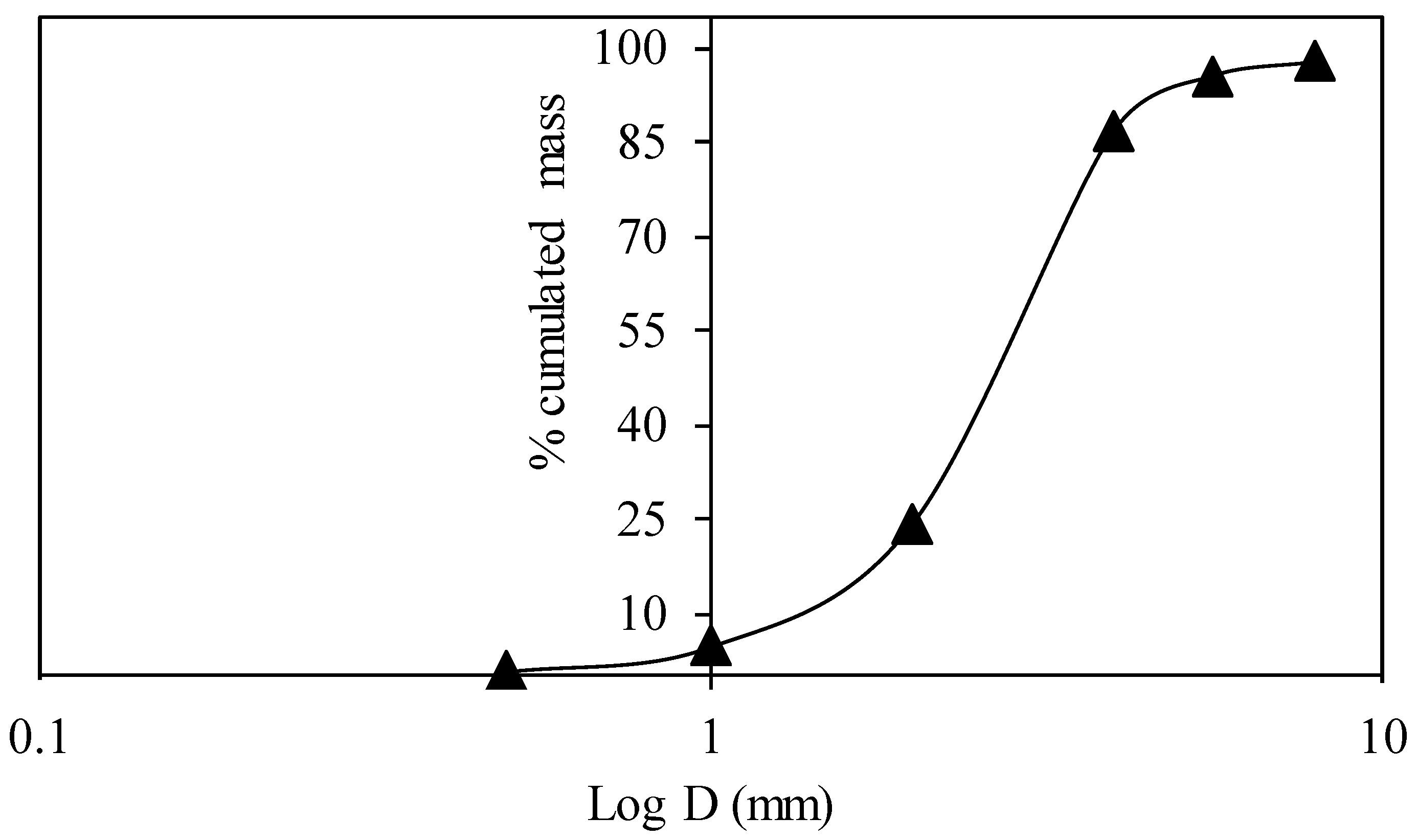
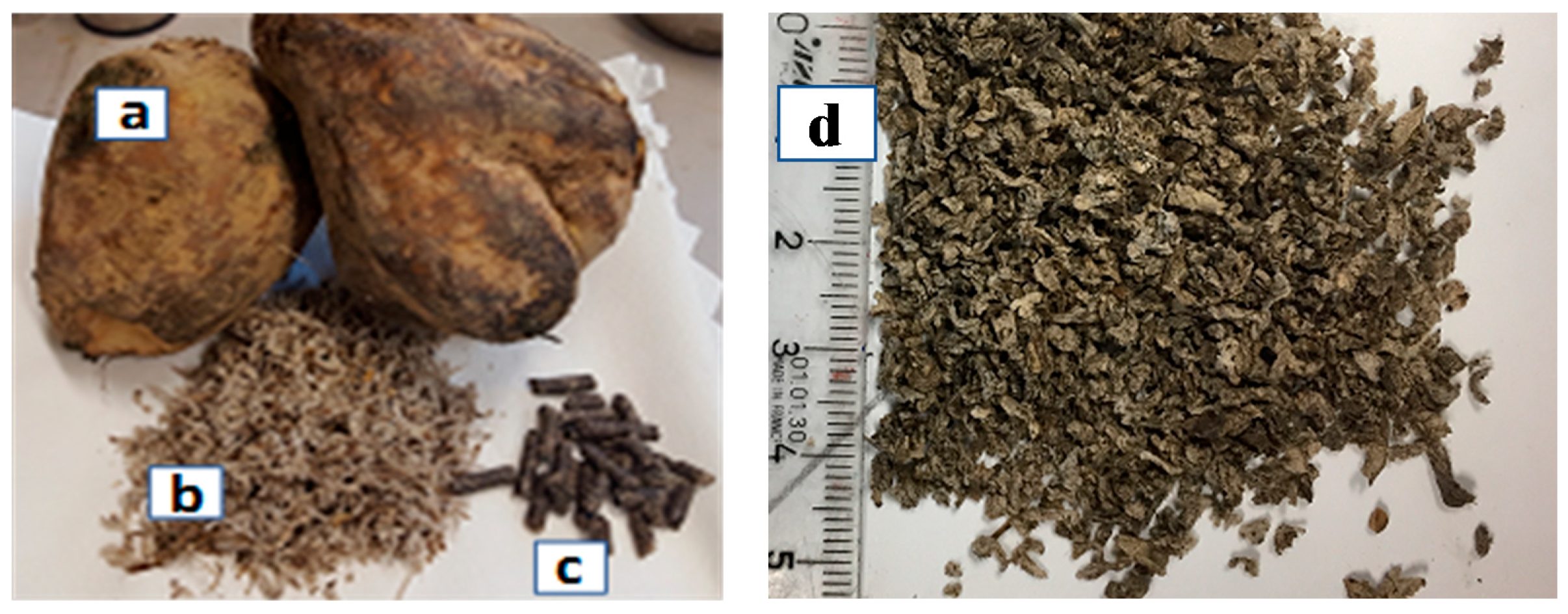

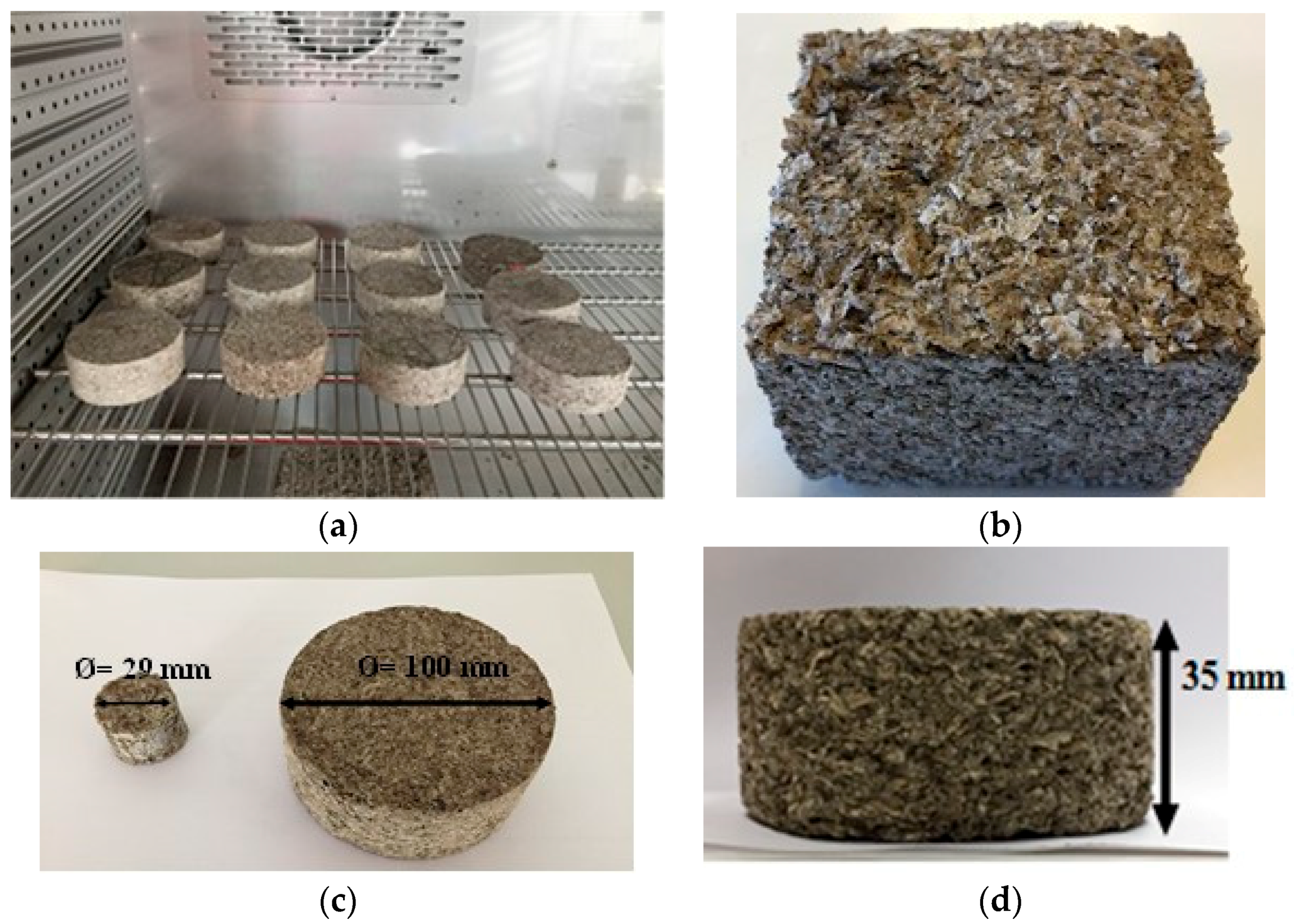



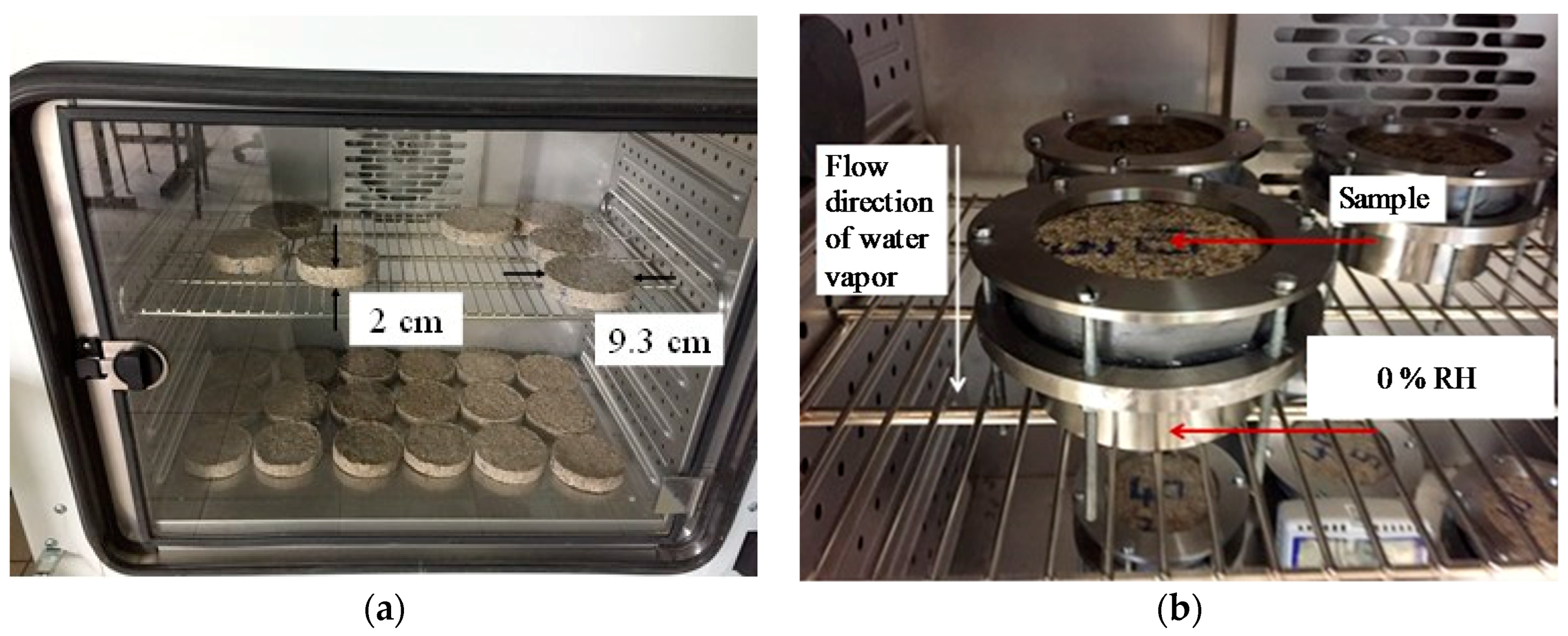
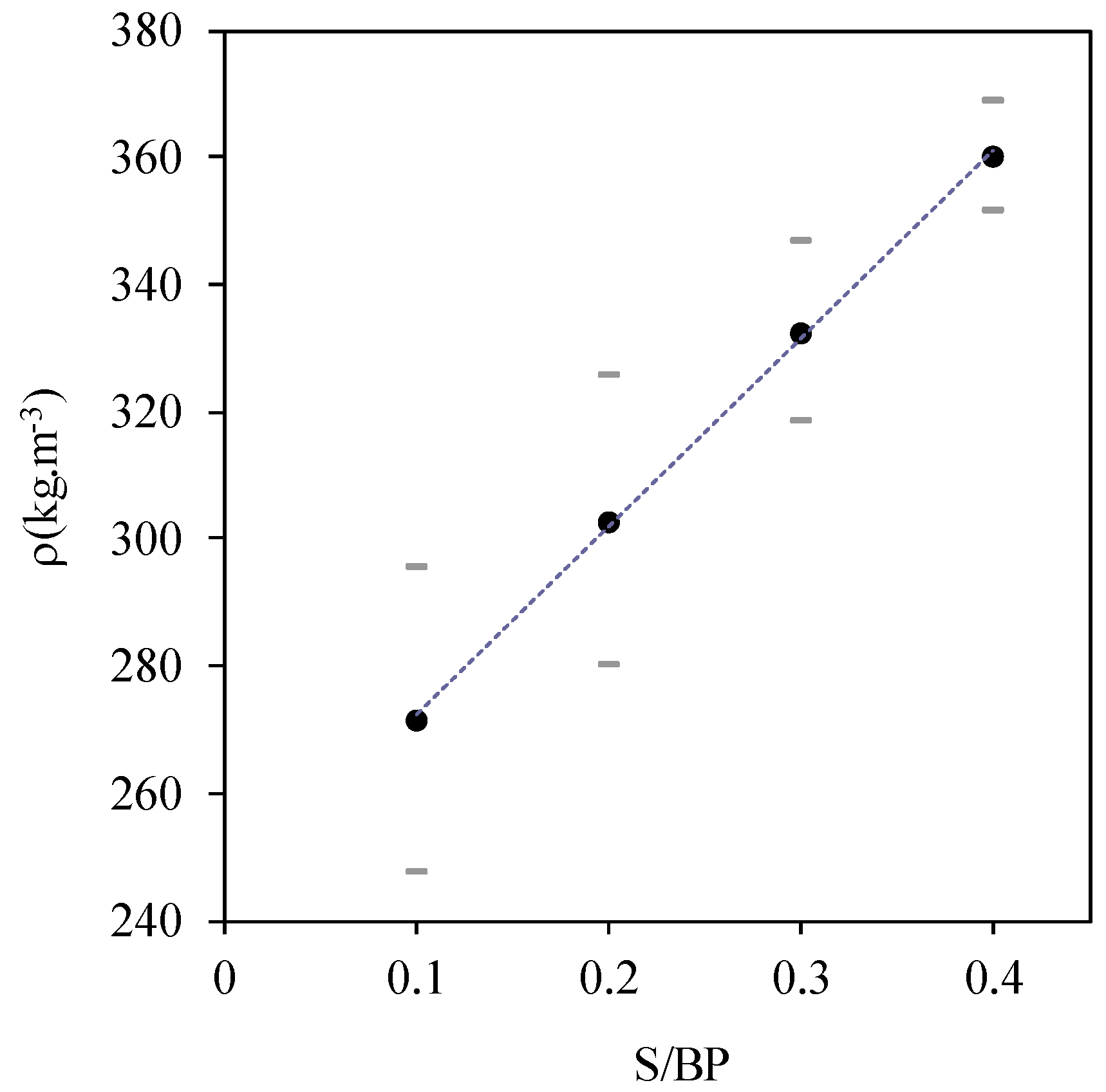
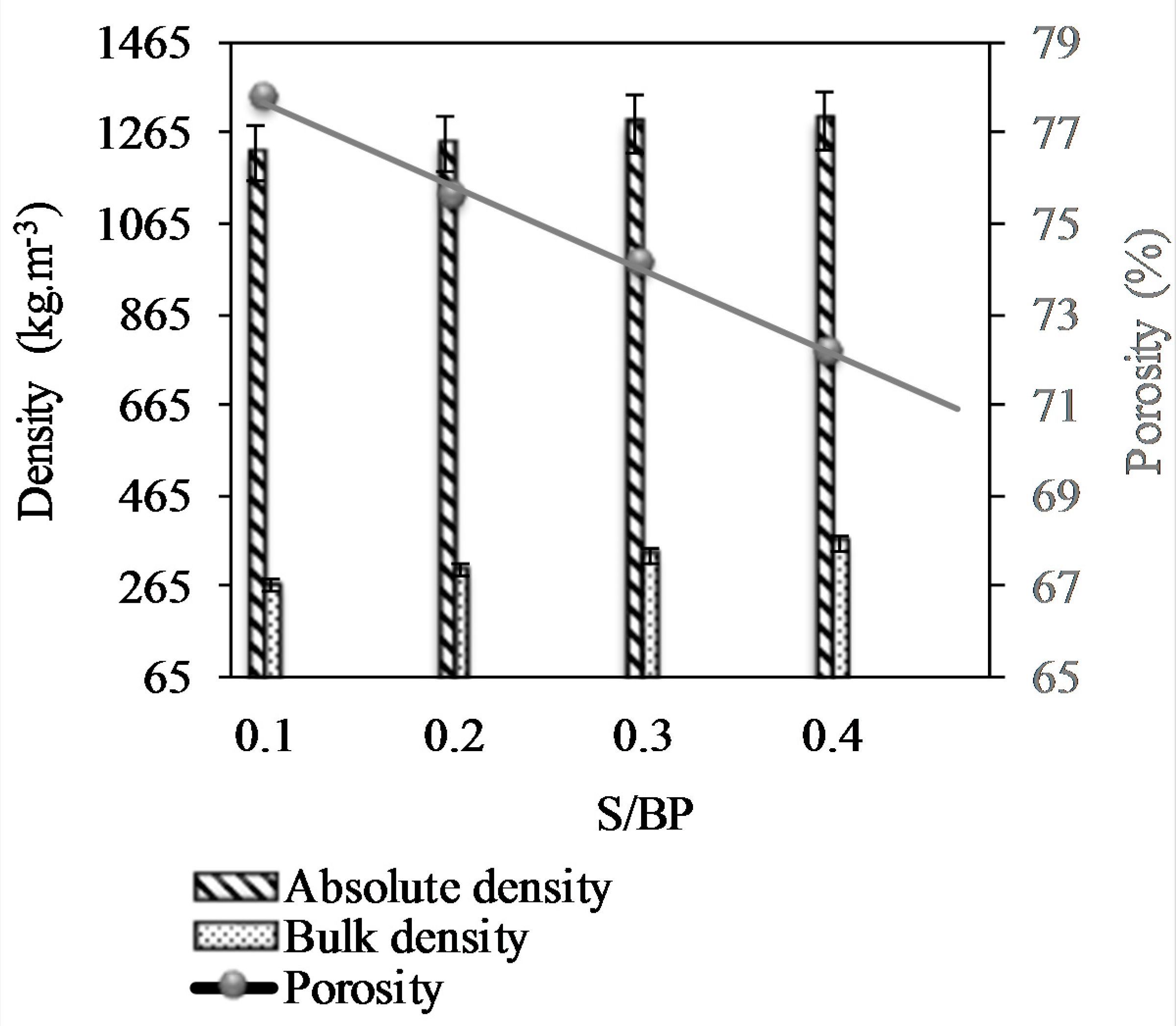

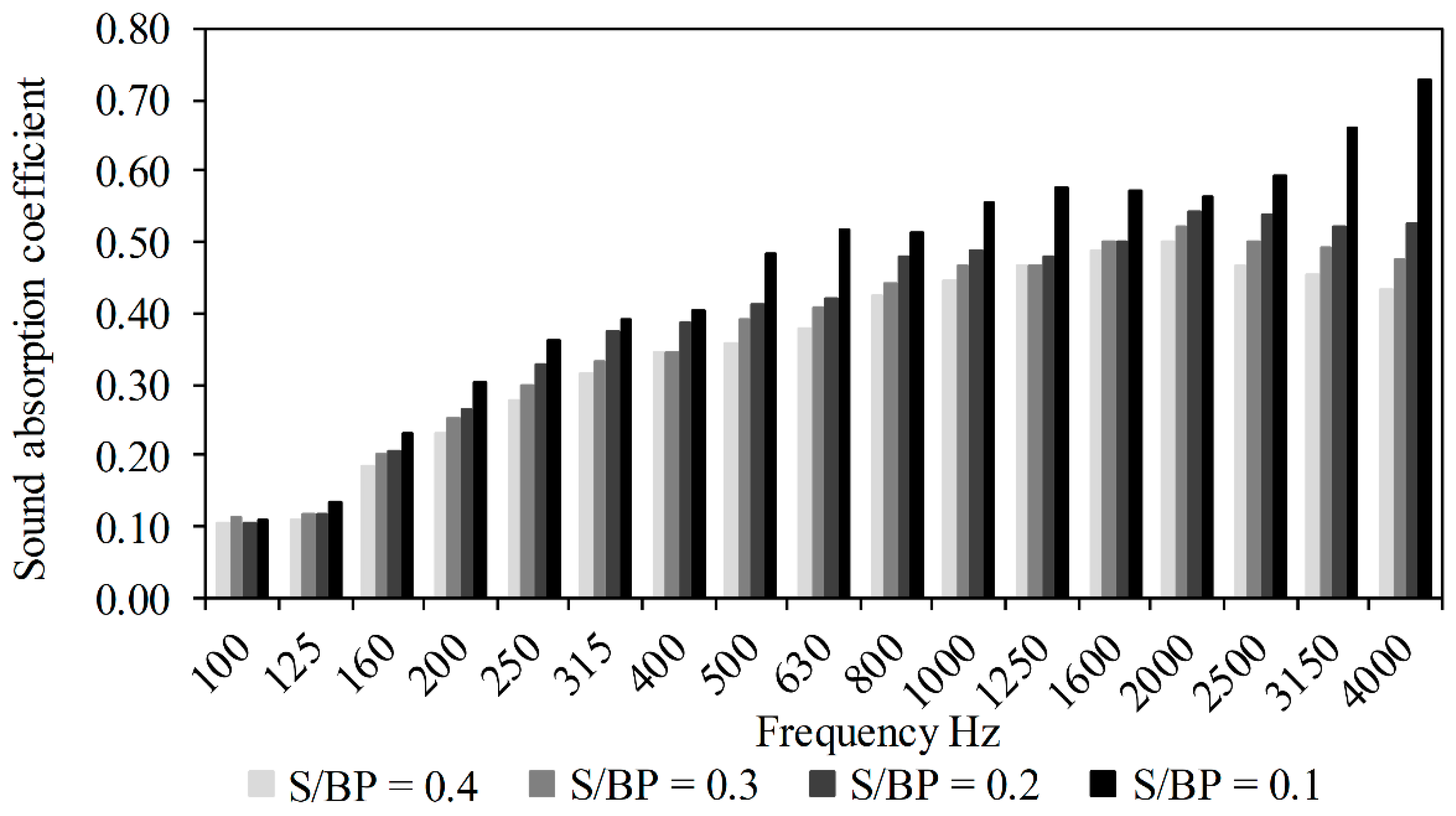
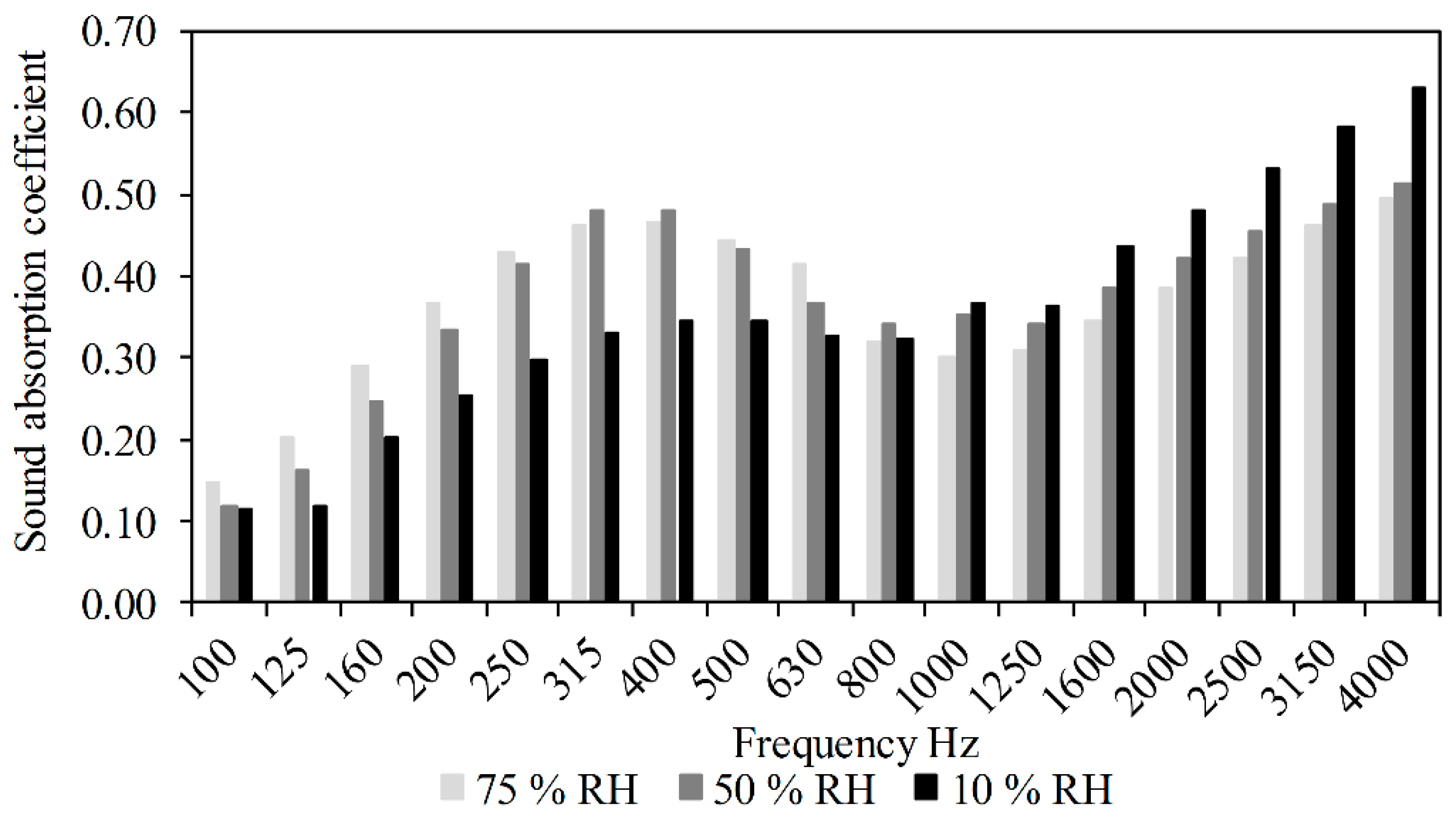

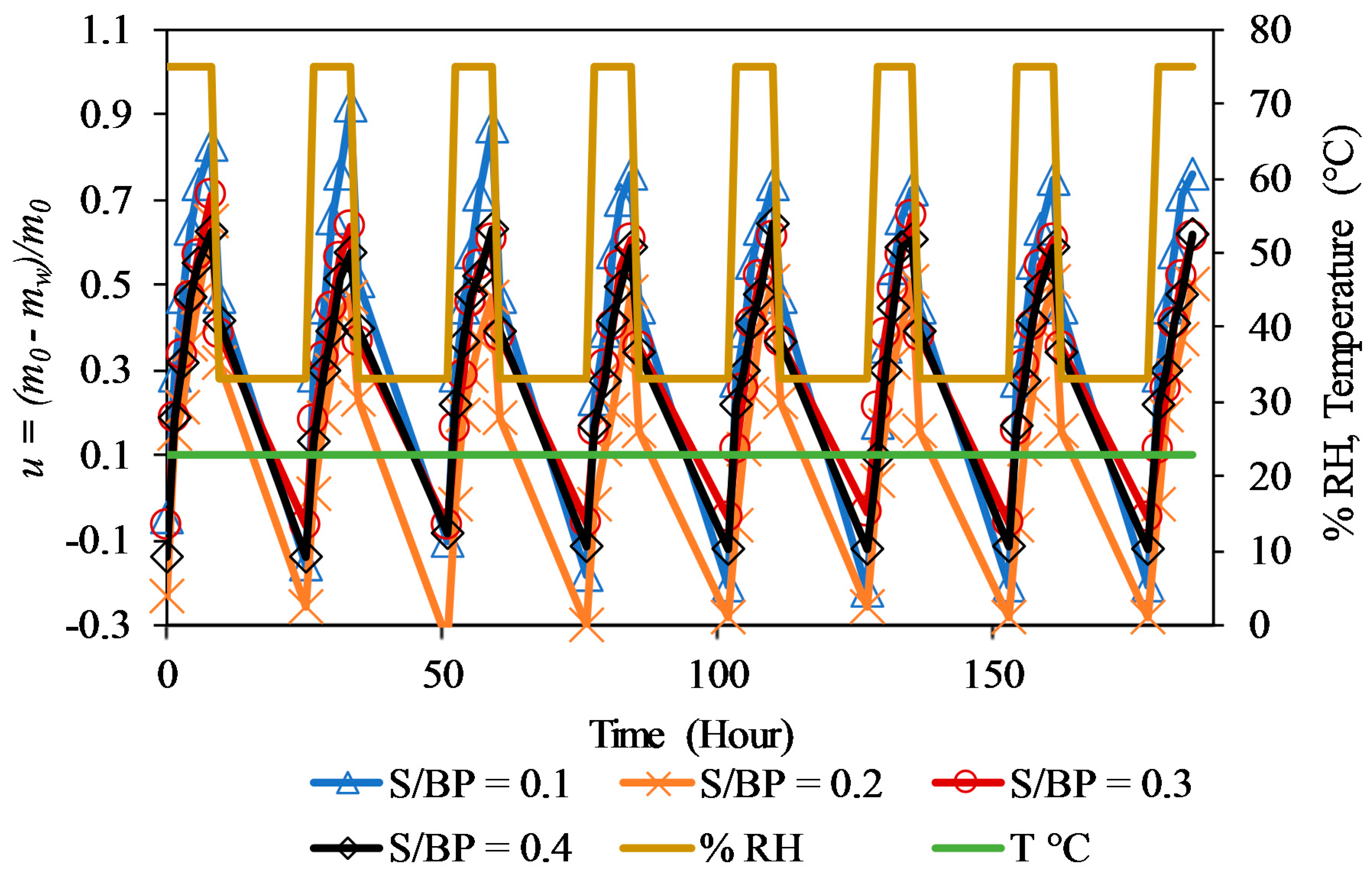
| Aggregates | ρapp (kg·m−3) | ρabs (kg·m−3) | Porosity (%) |
|---|---|---|---|
| Fresh beet pulp | 134 ± 6.7 | 911.6 ± 45.6 | 85.3 |
| Extruded beet pulp | 194 ± 7.9 | 1073.4 ± 53.7 | 81.9 |
| S/BP Mass Ratio | λ (W·m−1·K−1) | a (m2·s−1) | b (J·K−1·m−2·s−1/2) |
|---|---|---|---|
| 0.1 | 0.069 ± 0.0006 | 1.76 ± 0.058 × 10−7 | 165.5 ± 3.6 |
| 0.2 | 0.071 ± 0.0005 | 1.66 ± 0.0713 × 10−7 | 175.2 ± 3.8 |
| 0.3 | 0.072 ± 0.0003 | 1.50 ± 0.052 × 10−7 | 186.8 ± 3.5 |
| 0.4 | 0.075 ± 0.0002 | 1.47 ± 0.042 × 10−7 | ±5.7 |
| Samples | λexp (W·m−1·K−1) | n | λs |
|---|---|---|---|
| S/BP 0.1 | 0.069 | 0.7779 | 0.299 |
| S/BP 0.2 | 0.071 | 0.7559 | 0.283 |
| S/BP 0.3 | 0.072 | 0.7413 | 0.272 |
| S/BP 0.4 | 0.075 | 0.7216 | 0.267 |
| Beet pulp | 0.062 | 0.8193 | 0.315 |
| Starch gel | 0.1396 | 0.3857 | 0.2411 |
| Mass Ratio (S/BP) | δv × 10−12 (kg·m−1·s−1·Pa−1) | μ |
|---|---|---|
| 0.1 | 8.90 ± 0.211 | 22.48 ± 0.54 |
| 0.2 | 7.77 ± 0.169 | 25.72 ± 0.55 |
| 0.3 | 7.35 ± 0.154 | 27.20 ± 0.58 |
| 0.4 | 6.86 ± 0.236 | 29.12 ± 1.01 |
| Models | Parameters | Samples S/BP = 0.1 |
|---|---|---|
| Merakeb | a | 1.5425 |
| b | 0.2410 | |
| us | 0.2211 | |
| E (%) | 1.1689 | |
| R2 | 0.9998 | |
| RMSE | 0.1114 | |
| GAB | Wm | 2.2848 |
| CG | 0.0938 | |
| K | 0.4024 | |
| E (%) | 5.5864 | |
| R2 | 0.9994 | |
| RMSE | 0.2484 | |
| Van Genuchten (VG) | Us | 0.1921 |
| ηT | 2.2379 | |
| αT | 0.0002 | |
| E (%) | 10.4050 | |
| R2 | 0.9982 | |
| RMSE | 0.3936 |
| Sample S/BP | MBV (g·m−2 % RH−1) | SD |
|---|---|---|
| 0.1 | 2.62 | 0.060 |
| 0.2 | 2.68 | 0.065 |
| 0.3 | 2.72 | 0.080 |
| 0.4 | 2.80 | 0.090 |
© 2018 by the authors. Licensee MDPI, Basel, Switzerland. This article is an open access article distributed under the terms and conditions of the Creative Commons Attribution (CC BY) license (http://creativecommons.org/licenses/by/4.0/).
Share and Cite
Karaky, H.; Maalouf, C.; Bliard, C.; Moussa, T.; El Wakil, N.; Lachi, M.; Polidori, G. Hygrothermal and Acoustical Performance of Starch-Beet Pulp Composites for Building Thermal Insulation. Materials 2018, 11, 1622. https://doi.org/10.3390/ma11091622
Karaky H, Maalouf C, Bliard C, Moussa T, El Wakil N, Lachi M, Polidori G. Hygrothermal and Acoustical Performance of Starch-Beet Pulp Composites for Building Thermal Insulation. Materials. 2018; 11(9):1622. https://doi.org/10.3390/ma11091622
Chicago/Turabian StyleKaraky, Hamzé, Chadi Maalouf, Christophe Bliard, Tala Moussa, Nadim El Wakil, Mohammed Lachi, and Guillaume Polidori. 2018. "Hygrothermal and Acoustical Performance of Starch-Beet Pulp Composites for Building Thermal Insulation" Materials 11, no. 9: 1622. https://doi.org/10.3390/ma11091622





